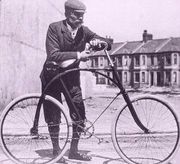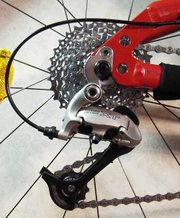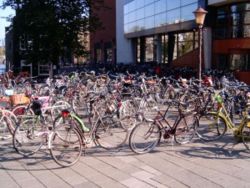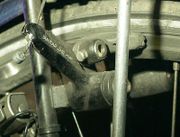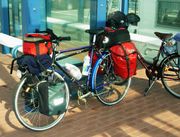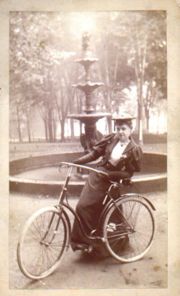Bicycle
2007 Schools Wikipedia Selection. Related subjects: Road transport

A bicycle, or bike, is a pedal-driven human-powered vehicle with two wheels attached to a frame, one behind the other. The International Union of Cycling adds the provision that the seat be more or less above the pedals, thus excluding recumbent bicycles.
First introduced in 19th-century Europe, bicycles now number over one billion worldwide, providing the principal means of transportation in many regions, notably China and the Netherlands. They are also a popular form of recreation, and have been adapted for use in many other fields of human activity, including children's toys, adult fitness, military and local police applications, courier services, and cycle sports.
The basic shape and configuration of the bicycle's frame, wheels, pedals, saddle, and handlebars have hardly changed since the first chain-driven model was developed around 1885 , although many important details have since been improved, especially since the advent of modern materials and computer-aided design. These have allowed for a proliferation of specialized designs for individuals who pursue a particular type of cycling.
The bicycle has affected history considerably, in both the cultural and industrial realms. In its early years, bicycle construction drew on pre-existing technologies; more recently, bicycle technology has, in turn, contributed ideas in both old and newer areas.
History
Several inventors and innovators contributed to the development of the bicycle. Its earliest known forebears were called velocipedes, and included many types of human-powered vehicles. One of these, the scooter-like dandy horse of the French Comte de Sivrac, dating to 1790, was long cited as the earliest bicycle. Most bicycle historians now believe that these hobbyhorses with no steering mechanism probably never existed, but were made up by Louis Baudry de Saunier, a 19th-century French bicycle historian. However, the term hobbyhorse was later applied to the first documented ancestor of the modern bicycle, first introduced to the public in Paris by the German Baron Karl Drais in 1818..
The ancestor of the bicycle was first created by a German Baron, Karl Drais, who invented and patented his machine in 1817. So the first bicycle ride was from his residence town Mannheim to the suburb Rheinau. A number of these draisines or dandy horses still exist, including one at the Paleis het Loo museum in Apeldoorn, the Netherlands. These were pushbikes, powered by the action of the rider's feet pushing against the ground. The Draisienne had two in-line wheels connected by a wooden frame. The rider sat astride and pushed it along with his feet, while steering the front wheel.
Scottish blacksmith Kirkpatrick MacMillan refined this in 1839 by adding a mechanical crank drive to the rear wheel, thus creating the first true "bicycle" in the modern sense. His system employed a pair of treadle drives connected by rods to a rear wheel crank, rather like a steam locomotive's driveshaft. Although the design was copied by at least two other Scottish builders, it was overtaken in popularity and influence by an inferior one.
In the 1850s and 1860s, Frenchmen Ernest Michaux and Pierre Lallement took bicycle design in a different direction, placing the pedals on an enlarged front wheel. Their creation, which came to be called the "Boneshaker", featured a heavy steel frame on which they mounted wooden wheels with iron tires. Lallement emigrated to the United States, where he recorded a patent on his bicycle in 1866 in New Haven, Connecticut. The Boneshaker was further refined by Englishman James Starley in the 1870s. He mounted the seat more squarely over the pedals so that the rider could push more firmly, and further enlarged the front wheel to increase the potential for speed. With tires of solid rubber, his machine became known as the ordinary. British cyclists likened the disparity in size of the two wheels to their coinage, nicknaming it the penny-farthing. The primitive bicycles of this generation were difficult to ride, and the high seat and poor weight distribution made for dangerous falls.
The subsequent dwarf ordinary addressed some of these faults by adding gearing, reducing the front wheel diameter, and setting the seat further back, with no loss of speed. Having to both pedal and steer via the front wheel remained a problem. Starley's nephew, J. K. Starley, J. H. Lawson, and Shergold solved this problem by introducing the chain and producing rear-wheel drive. These models were known as dwarf safeties, or safety bicycles, for their lower seat height and better weight distribution. Starley's 1885 Rover is usually described as the first recognizably modern bicycle. Soon, the seat tube was added, creating the double-triangle, diamond frame of the modern bike.
While the Starley design was much safer, the return to smaller wheels made for a bumpy ride. The next innovations increased comfort and ushered in the 1890s Golden Age of Bicycles. In 1888, Scotsman John Boyd Dunlop introduced the pneumatic tire, which soon became universal. Soon after, the rear freewheel was developed, enabling the rider to coast without the pedals spinning out of control. This refinement led to the 1898 invention of coaster brakes. Derailleur gears and hand-operated, cable-pull brakes were also developed during these years, but were only slowly adopted by casual riders. By the turn of the century, bicycling clubs flourished on both sides of the Atlantic, and touring and racing were soon extremely popular.
Successful early bicycle manufacturers included Englishman Frank Bowden and German builder Ignaz Schwinn. Bowden started the Raleigh company in Nottingham in the 1890s, and was soon producing some 30,000 bicycles a year. Schwinn emigrated to the United States, where he founded his similarly successful company in Chicago in 1895. Schwinn bicycles soon featured widened tires and spring-cushioned, padded seats, sacrificing a certain amount of efficiency for increased comfort. Facilitated by connections between European nations and their overseas colonies, European-style bicycles were soon available worldwide. By the mid-20th century, bicycles had become the primary means of transportation for millions of people around the globe.
In many western countries, the use of bicycles levelled off or declined as motorized transportation became affordable and car-centred policies led to an increasingly hostile environment for bicycles. In North America, bicycle sales declined markedly after 1905, to the point where, by the 1940s, they had largely been relegated to the role of children's toys. However, in other parts of the world, such as China, India, and European countries such as Germany, Denmark, and the Netherlands, the traditional utility bicycle remained a mainstay of transportation; its design changed only gradually to incorporate hand-operated brakes, with internal hub gears allowing up to seven speeds. In the Netherlands, such so-called 'granny bikes' have remained popular, and are again in production. In the early 1980s, Swedish company Itera invented a new type of bicycle, called the Itera plastic bicycle, made entirely out of plastics. The plastic bicycle was however a commercial failure.
In North America, increasing consciousness of physical fitness and environmental preservation spawned a renaissance of bicycling in the late 1960s. Bicycle sales in the US boomed, largely in the form of the racing bicycles, long used in such events as the hugely popular Tour de France. Sales were also helped by a number of technical innovations that were new to the US market, including higher performance steel alloys and gearsets with an increasing number of gears. While 10-speeds were very popular in the 1970s, 12-speed designs were introduced in the 1980s, and today most bikes feature 18 or more speeds. By the 1980s, these newer designs had driven the three-speed bicycle from the roads. In the late 1980s, the mountain bike became particularly popular, and in the 1990s something of a major fad. These task-specific designs led many American recreational cyclists to demand a more comfortable and practical product. Manufacturers responded with the hybrid bicycle, which restored many of the features long enjoyed by riders of the time-tested European utility bikes.
Technical aspects
Legal requirements
The 1968 Vienna Convention on Road Traffic considers a bicycle to be a vehicle, and a person controlling a bicycle is considered a driver. The traffic codes of many countries reflect these definitions and demand that a bicycle satisfy certain legal requirements, sometimes even including licensing, before it can be used on public roads. In many jurisdictions it is an offense to use a bicycle that is not in roadworthy condition. In most places, bicycles must have functioning front and rear lights or lamps when ridden after dark. As some generator or dynamo-driven lamps only operate while moving, rear reflectors are frequently also mandatory. Since a moving bicycle makes very little noise, in many countries bicycles must have a warning bell for use when approaching pedestrians, equestrians and other bicyclists.
Construction and parts
Frame
Nearly all modern upright bicycles feature the diamond frame, a truss, consisting of two triangles: the front triangle and the rear triangle. The front triangle consists of the head tube, top tube, down tube and seat tube. The head tube contains the headset, the set of bearings that allows the fork to spin smoothly. The top tube connects the head tube to the seat tube at the top, and the down tube connects the head tube to the bottom bracket. The rear triangle consists of the seat tube and paired chain stays and seat stays. The chain stays run parallel to the chain, connecting the bottom bracket to the rear dropouts. The seat stays connect the top of the seat tube at or near the same point as the top tube) to the rear dropouts.
Historically, women's bicycle frames had a top tube that connected in the middle of the seat tube instead of the top, resulting in a lower standover height at the expense of compromised structural integrity, since this places a strong bending load in the seat tube, and bicycle frame members are typically weak in bending. This design purportedly allows the rider to mount and dismount in a dignified way while wearing a skirt or dress, although this is difficult on a properly-sized diamond frame. While some women's bicycles continue to use this frame style, there is also a hybrid form, the mixte or step-through frame, which splits the top tube into two small top tubes that bypass the seat tube and connect to the rear dropouts. The ease of stepping through is also appreciated by those with limited flexibility or other joint problems. Unfortunately for the old tall man, because of its persistent image as a "women's" bicycle, the vast majority of mixte frames are quite small.
Historically, materials used in bicycles have followed a similar pattern as in aircraft, the goal being strength and low weight. Since the late 1930s alloy steels have been used for frame and fork tubes in higher quality machines. Celluloid found application in mudguards, and aluminium alloys are increasingly used in components such as handlebars, seat post, and brake levers. In the 1980s aluminium alloy frames became popular, and their affordability now makes them common. More expensive carbon fibre and titanium frames are now also available, as well as advanced steel alloys.
Drivetrain
The drivetrain begins with pedals which rotate the cranks, which fit into the bottom bracket. Attached to the right crank is the chainring or sprocket which drives the chain, which in turn rotates the rear wheel via the rear sprockets, or cassette. Various gearing systems, described below, may be interspersed between the pedals and rear wheel; these gearing systems vary the number of rear wheel revolutions produced by each turn of the pedals.
Since cyclists' legs produce a limited amount of power most efficiently over a narrow range of cadences, a variable gear ratio is needed to maintain an optimum pedaling speed while covering varied terrain. The gear systems are usually hand-operated, via cables, and are of two types.
- Internal hub gearing works by planetary, or epicyclic, gearing, in which the outer case of the hub gear unit turns at a different speed relative to the rear axle depending on which gear is selected. Rear hub gears may offer 2, 3, 4, 5, 6, 7, 8, 9, 12, or 14 speeds. Bottom bracket fittings offer a choice of 2 speeds, and are generally foot-operated.
- External gearing utilizes derailleurs, which can be placed on both the front chainring and on the rear cluster or cassette, to push the chain to either side, derailing it from the sprockets. The sides of the gear rings catch the chain, pulling it up onto their teeth to change gears. There may be 1 to 3 chainrings, and 5 to 10 sprockets on the cassette.
Internal hub gears are immune to adverse weather conditions that affect derailleurs, and often last longer and require less maintenance. However, they may be heavier and/or more expensive, and often do not offer the same range or number of gears. Internal hub gearing still predominates in some regions, particularly on utility bikes, whereas in other regions, such as the USA, external derailleur systems predominate.
Road bicycles have close set multi-step gearing, which allows very fine control of cadence, while utility cycles offer fewer, more widely spaced speeds. Mountain bikes and most entry-level road racing bikes may offer an extremely low gear to facilitate climbing slowly on steep hills.
Fixed-gear track racing bikes can achieve transmission efficiencies of over 99% (nearly all the energy put in at the pedals ends up at the wheel). Biomechanical factors however determine that a human can deliver maximum power only over a narrow range of crank rotational speed or cadence. To match the power source with the load under varying conditions, a variable gear ratio is needed, and they work very well, though at the expense of mechanical efficiency. The efficiency varies considerably with the gear ratio being used. In a typical hub gear mechanism the mechanical efficiency will be between 82% and 92% depending on the ratio selected. Which ratios are best and worst depends on the specific model of hub gear. Derailleur type mechanisms fare better, with a typical mid-range product (of the sort used by serious amateurs) achieving between 88% and 99% efficiency at 100W. In derailleur mechanisms the highest efficiency is achieved by the larger cogs. Efficiency generally decreases with smaller cog and chainwheel sizes. Derailleur efficiency is also compromised with cross-chaining, or running large-ring to large-cog or small-ring to small-cog. This also results in increased wear because of the lateral deflection of the chain.
There have been, and still are, drivetrains that are quite different from these:
- Retro-Direct drivetrains used on some early 20th century bicycles have been resurrected by bicycle hobbyists. These have two gears but no gear lever; the operator simply pedals forward for one gear and backward for the other.
- Other bicycles of that era dispensed with the chain entirely and used an enclosed driveshaft and bevel gears. These shaft-driven bicycle were strongly built but were not mechanically efficient. They were primarily marketed to women, as the enclosed gears would not entangle clothing. In recent years, a small number of shaft-drive systems have reappeared on the market as a specialty item .
- In recent years, Steve Christini and Mike Dunn added a two-wheel drive option to bicyclists. Their AWD system, aimed at mountain bikers, comprises an adapted differential that sends power to the front wheel once the rear begins to slip.
Steering and seating
The handlebars turn the fork and the front wheel via the stem, which articulates with the headset. Three styles of handlebar are common. Upright handlebars, the norm in Europe and elsewhere until the 1970s, curve gently back toward the rider, offering a natural grip and comfortable upright position. Drop handlebars are "dropped", offering the cyclist either an aerodynamic "crouched" position or a more upright posture in which the hands grip the brake lever mounts. Mountain bikes feature a straight handlebar, which helps prevent the rider from pitching over the front in case of sudden deceleration.
Variations on these styles exist. Bullhorn style handlebars are often seen on modern time trial bicycles, equipped with two forward-facing extensions, allowing a rider to rest the entire forearm on the bar. These are usually used in conjunction with the aero bar, a pair of forward-facing extensions spaced close together, to promote better aerodynamics. The Bullhorn was banned from ordinary road racing because it is difficult for the rider to control in bike traffic.
Saddles also vary with rider preference, from the cushioned ones favoured by short-distance riders to narrower saddles which allow more free leg swings. Comfort depends on riding position. With comfort bikes and hybrids the cyclist sits high over the seat, their weight directed down onto the saddle, such that a wider and more cushioned saddle is preferable. For racing bikes where the rider is bent over, weight is more evenly distributed between the handlebars and saddle, and the hips are flexed, and a narrower and harder saddle is more efficient.
A recumbent bicycle has a reclined chair-like seat that is more comfortable than a saddle, especially for riders who suffer from certain types of back pain.
Brakes
Modern bicycle brakes are either rim brakes, in which friction pads are compressed against the wheel rims, internal hub brakes, in which the friction pads are contained within the wheel hubs, or disc brakes. A rear hub brake may be either hand-operated or pedal-actuated, as in the back pedal coaster brakes which were the rule in North America until the 1960s. Hub drum brakes do not cope well with extended braking, so rim brakes are favoured in hilly terrain. With hand-operated brakes, force is applied to brake handles mounted on the handle bars and then transmitted via Bowden cables to the friction pads. In the late 1990s, disc brakes appeared on some off-road bicycles, tandems and recumbent bicycles, but are considered impractical on road bicycles, which rarely encounter conditions where the advantages of discs are significant.
The advantages of discs make them well-suited to steep, extended downhills through wet and muddy off-road terrain, which falls under the category of downhill and freeride bicycle riding. The use of tires as large as 3.0 inches in width also makes disc brakes a necessity, as rim brakes simply cannot straddle a tire that wide.
Two main disc brake systems exist: hydraulic and mechanical (cable-actuated). Mechanical disc brakes have less modulation than hydraulic disc brake systems, and since the cable is usually open to the outside, mechanical disc brakes tend to pick up small bits of dirt and grit in the cable lines when ridden in harsh terrain. Hydraulic disc brake systems generally keep contaminants out better. However, since hydraulic disc brakes usually require relatively specialized tools to bleed the brake systems, repairs on the trail are difficult to perform, whereas mechanical disc brakes rarely fail. Also, the hydraulic fluid may boil on steep, continuous downhills. This is due to heat building up in the disc and pads and can cause the brake to lose its ability to transmit force through incompressible fluids, since some of it has become a gas, which is compressible. To avoid this problem, 203 mm (8 inch) diameter disc rotors have become common on downhill bikes. Larger rotors dissipate heat more quickly and have a larger amount of mass to absorb heat. For these reasons, one must weigh the advantages and disadvantages of using a hydraulic system versus a mechanical system.
For track cycling, track bicycles do not have brakes. Most track bike frames and forks do not have holes for mounting brakes, although with their increasing popularity among some road cyclists, some manufacturers have drilled their track frames to enable the fitting of brakes. Brakes are not required for riding on a track because all riders ride in the same direction and there are no corners or other traffic. Track rider are still able to slow down because all track bicycles are fixed, meaning that there is no freewheel. Without a freewheel, coasting is impossible, so when the rear wheel is moving, the crank is moving. To slow down one may apply resistance to the pedals. Cyclists who ride a track bike without brake(s) on the road can also slow down by skidding, by unweighting the rear wheel and applying a backwards force to the pedals, causing the rear wheel to lock up and slide along the road.
Accessories and Repairs
Some components, which are often optional accessories on sports bicycles, are standard features on utility bicycles to enhance their usefulness and comfort. Chainguards and mudguards, or fenders, protect clothes and moving parts from oil and spray. Kick stands help with parking. Front-mounted wicker or steel baskets for carrying goods are often used. Rear racks or carriers can be used to carry items such as school satchels. Parents sometimes add rear-mounted child seats and/or an auxiliary saddle fitted to the crossbar to transport children.
Toe-clips and toestraps, or clipless pedals, help to keep the foot planted firmly on the pedals, and enable the cyclist to pull as well as push the pedals. Technical accessories include solid-state speedometers and odometers for measuring distance. Other accessories include lights, reflectors, tire pump, security lock, mirror, and horn. A bicycle helmet is classified by some as an accessory, but as an item of clothing by others.
Many cyclists carry tool kits, containing at least a tire patch kit (and/or a spare tube), tire levers, and allen wrenches. A single tool once sufficed for most repairs. More specialised parts now require more complex tools, including proprietary tools specific for a given manufacturer. Some bicycle parts, particularly hub-based gearing systems, are complex, and many prefer to leave maintenance and repairs to professionals. Others maintain their own bicycles, enhancing their enjoyment of the hobby of cycling.
It is also possible to purchase road-side assistance from companys such as the Better World Club.
Performance
In both biological and mechanical terms, the bicycle is extraordinarily efficient. In terms of the amount of energy a person must expend to travel a given distance, investigators have calculated it to be the most efficient self-powered means of transportation. From a mechanical viewpoint, up to 99% of the energy delivered by the rider into the pedals is transmitted to the wheels, although the use of gearing mechanisms may reduce this by 10-15%. In terms of the ratio of cargo weight a bicycle can carry to total weight, it is also a most efficient means of cargo transportation.
A human being travelling on a bicycle at low to medium speeds of around 10-15 mph (16-24 km/h), using only the energy required to walk, is the most energy-efficient means of transport generally available. Air drag, which increases with the square of speed, requires increasingly higher power outputs relative to speed. A bicycle which places the rider in a seated position, supine position or, more rarely, prone position, and which may be covered in an aerodynamic fairing to achieve very low air drag, is referred to as a recumbent bicycle or human powered vehicle. Humans create the greatest amount of drag on an upright bicycle at about 75% of the total drag.
Dynamics
A bicycle stays upright by being steered so as to keep its centre of gravity over its wheels. This steering is usually provided by the rider, but under certain conditions may be provided by the bicycle itself.
A bicycle must lean in order to turn. This lean is induced by a method known as countersteering, which can be performed by the rider turning the handlebars directly with the hands or indirectly by leaning the bicycle.
Short-wheelbase or tall bicycles, when braking, can generate enough stopping force at the front wheel in order to flip longitudinally. This action, especially if performed on purpose, is known as a stoppie or front wheelie.
Social and historical aspects
Economic implications
Bicycle manufacturing proved to be a training ground for other industries and led to the development of advanced metalworking techniques, both for the frames themselves and for special components such as ball bearings, washers, and sprockets. These techniques later enabled skilled metalworkers and mechanics to develop the components used in early automobiles and aircrafts. J. K. Starley's company became the Rover Cycle Company Ltd. in the late 1890s, and then the Rover auto maker. The Morris Motor Company (in Oxford) and Škoda also began in the bicycle business, as did Henry Ford and the Wright Brothers.
Some bicycle clubs and national associations became prominent advocates for improvements to roads and highways. In the United States, the League of American Wheelmen lobbied for the improvement of roads in the last part of the 19th century, founding and leading the national Good Roads Movement. Both their model for political organization and the paved roads for which they argued facilitated the growth of the bicycle's rival, the automobile.
Until recently cycle manufacturers in the west generally built their own frames and used components made by other companies to assemble a complete cycle, although very large companies such as Raleigh used to make almost every part of a bicycles including eg bottom bracket axles etc. In recent years, US and European bicycle makers have changed their methods of production. Many companies now only assemble, every part of the bicycle including the frame will have been made by other companies. Many newer or smaller companies do no manufacturing or even assembly at all, they only deal with design and marketing, actual manufacturing is done by other companies. Some sixty percent of the world's bicycles are now being made in China. Despite this shift in production, as nations such as China and India become more wealthy, their own use of bicycles has declined due to the increasing affordability of cars and motorcycles. One of the major reasons for the proliferation of Chinese-made bicycles in foreign markets is the lower cost of labour in China.
Female emancipation
The diamond-frame safety bicycle gave women unprecedented mobility, contributing to their emancipation in Western nations. As bicycles became safer and cheaper, more women had access to the personal freedom they embodied, and so the bicycle came to symbolise the New Woman of the late nineteenth century, especially in Britain and the United States.
The bicycle was recognised by nineteenth-century feminists and suffragists as a "freedom machine" for women. American Susan B. Anthony said in a New York World interview on February 2, 1896: "Let me tell you what I think of bicycling. I think it has done more to emancipate women than anything else in the world. It gives women a feeling of freedom and self-reliance. I stand and rejoice every time I see a woman ride by on a wheel...the picture of free, untrammeled womanhood." In 1895 Frances Willard, the tightly-laced president of the Women’s Christian Temperance Union, wrote a book called How I Learned to Ride the Bicycle, in which she praised the bicycle she learned to ride late in life, and which she named "Gladys", for its "gladdening effect" on her health and political optimism. Willard used a cycling metaphor to urge other suffragists to action, proclaiming, "I would not waste my life in friction when it could be turned into momentum."
The male anger at the freedom symbolised by the New (bicycling) Woman was demonstrated when the male undergraduates of Cambridge University chose to show their opposition to the admission of women as full members of the university by hanging a woman in effigy in the main town square -- tellingly, a woman on a bicycle. This was as late as 1897.
In the 1890s the bicycle craze led to a movement for so-called rational dress, which helped liberate women from corsets and ankle-length skirts and other restrictive garments, substituting the then-shocking bloomers.
Other social implications
Sociologists suggest that bicycles enlarged the gene pool for rural workers, by enabling them to easily reach the next town and increase their courting radius. In cities, bicycles helped reduce crowding in inner-city tenements by allowing workers to commute from more spacious dwellings in the suburbs. They also reduced dependence on horses, with all the knock-on effects this brought to society. Bicycles allowed people to travel for leisure into the country, since bicycles were three times as energy efficient as walking, and three to four times as fast.
Cycling and public health
The physical exercise gained from cycling is generally linked with increased health and wellbeing. According to the World Health Organisation, physical inactivity is second only to tobacco smoking as a health risk in developed countries, and this is associated with many tens of billions of dollars of healthcare costs . The WHO's report suggests that increasing physical activity is a public health 'best buy', and that cycling is a 'highly suitable activity' for this purpose. The charity Sustrans reports that investment in cycling provision can give a 20:1 return from health and other benefits .
Cycling is not generally considered as a high-risk activity . In the UK, casualty rates per kilometer are comparable with walking, but are higher than for car occupants. Most cycle deaths result from a collision with a car or heavy goods vehicle .
A Danish study in 2000 concluded that cycling to work was linked to a 40% reduction in mortality rate; this included all causes of death, including road deaths.
Uses for bicycles
Bicycles at work
The postal services of many countries have long relied on bicycles. The British Royal Mail first started using bicycles in 1880; now bicycle delivery fleets include 37,000 in the UK, 25,700 in Germany, 10,500 in Hungary and 7000 in Sweden. The London Ambulance Service has recently introduced bicycling paramedics, who can often get to the scene of an incident in Central London more quickly than a motorised ambulance.
Police officers adopted the bicycle as well, initially using their own. However, they eventually became a standard issue, particularly for police in rural areas. The Kent police purchased 20 bicycles in 1896, and by 1904 there were 129 police bicycle patrols operating. Some countries retained the police bicycle while others dispensed with them for a time. Bicycle patrols are now enjoying a resurgence in many cities, as the mobility of car-borne officers is becoming increasingly limited by traffic congestion and pedestrianisation. They also have the advantages that the officers are inherently more open to the public, and the transport is quieter to permit a more stealthy approach toward suspects. The pursuit of suspects can also be assisted by a bicycle.
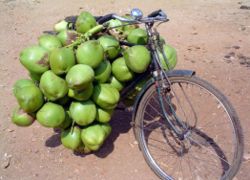
Bicycles enjoy substantial use as general delivery vehicles in many countries. In the UK and North America, generations of teenagers have got their first jobs delivering newspapers by bicycle. London has many delivery companies that use bicycles with trailers. Most cities in the West, and many outside it, support a sizable and visible industry of cycle couriers who deliver documents and small packages. In India, many of Mumbai's Dabbawalas use bicycles to deliver hot lunches to the city’s workers. In Bogotá, Colombia the city’s largest bakery recently replaced most of its delivery trucks with bicycles. Even the car industry uses bicycles. At the huge Mercedes-Benz factory in Sindelfingen, Germany workers use bicycles, colour-coded by department, to move around the factory.
Bicycle recreation
Bicycles are used for recreation at all ages. Bicycle touring, also known as cyclotourism, involves touring and exploration or sightseeing by bicycle for leisure. A brevet or randonnée is an organized long-distance ride.
One aspect of Dutch popular culture is enjoying relaxed cycling in the countryside of the Netherlands. The land is very flat and full of public bicycle trails where cyclist aren't bothered by cars and other traffic, which makes it ideal for cycling recreation. Many Dutch people subscribe every year to an event called fietsvierdaagse — four days of organised cycling through the local environment. Paris-Brest-Paris (PBP), which began in 1891, is the oldest bicycling event still run on a regular basis on the open road, covers over 1200 km and imposes a 90-hour time limit.
Bicycles and war
The bicycle is not suited for combat, but it has been used as a method of transporting soldiers and supplies to combat zones. Bicycles were used in the Second Boer War, where both sides used them for scouting. In World War I, France and Germany used bicycles to move troops. In its 1937 invasion of China, Japan employed some 50,000 bicycle troops, and similar forces were instrumental in Japan's march through Malaysia in World War II. Germany used bicycles again in World War II, while the British employed airborne Cycle-commandos with folding bikes.
In the Vietnam War, communist forces used bicycles extensively as cargo carriers along the Ho Chi Minh Trail. There are reports of mountain bicycles being used in scouting by U.S. Special Forces in the U.S. invasion of Afghanistan and in subsequent battles against the Taliban. British troops, designated Light Bicycle Infantry LBI were recently, as of 06 January 2005, using bicycles to patrol in Basra, Iraq.
The only country to recently maintain a regiment of bicycle troops was Switzerland, who disbanded the last unit in 2003.
Bicycle racing
Shortly after the introduction of bicycles, competitions developed independently in many parts of the world. Early races involving boneshaker style bicycles were predictably fraught with injuries. Large races became popular during the 1890's "Golden Age of Cycling", with events across Europe, and in the U.S. and Japan as well. At one point, almost every major city in the US had a velodrome or two for track racing events. However since the middle of the 20th Century cycling has become a minority sport in the US whilst in Continental Europe it continues to be a major sport, particularly in France, Belgium and Italy. The most famous of all bicycle races is the Tour de France. This began in 1903, and continues to capture the attention of the sporting world.
As the bicycle evolved its various forms, different racing formats developed. Road races may involve both team and individual competition, and are contested in various ways. They range from the one-day road race, criterium, and time trial to multi-stage events like the Tour de France and its sister events which make up cycling's Grand Tours. Recumbent bicycles were banned from bike races in 1934 after Marcel Berthet set a new hour record in his Velodyne streamliner (49.992 km on 18 November 1933). Track bicycles are used for track racing in Velodromes , while cyclo-cross races are held on rugged outdoor terrain. In the past decade, mountain bike racing has also reached international popularity and is even an Olympic sport.
The governing body of international cycle sport, the Union Cycliste Internationale, decided in the late 1990s to create additional rules restricting the design of racing bicycles. These rules met with considerable controversy and to some extent arrested the development of the racing bicycle. Their stated motive was so that developing countries could compete in international competitions without requiring large equipment budgets, and to re-focus attention on the athlete rather than the bicyle. For example, monocoque frames, such as used by Chris Boardman to win the Gold medal in 1992 Olympic individual pursuit event in Barcelona, were no longer permitted.
Modal share: cycle use in modern cities

Cyclists and motorists make different demands on road design which may lead to conflicts both in politics and on the streets. Some jurisdictions give priority to motorised traffic, for example setting up extensive one-way street systems, free-right turns, high capacity roundabouts, and slip roads. Other cities may apply active traffic restraint measures to limit the impact of motorised transport. In the former cases, cycling has tended to decline while in the latter it has tended to be maintained. Occasionally, extreme measures against cycling may occur. In Shanghai, a city where bicycles were once the dominant mode of transportation, bicycle travel on city roads was actually banned temporarily in December 2003.
In areas in which cycling is popular and encouraged, cycle-parking facilities using bicycle racks, lockable mini-garages, and patrolled cycle parks are used to reduce theft. Local governments also promote cycling by permitting the carriage of bicycles on public transport or by providing external attachment devices on public transport vehicles. Conversely, an absence of secure cycle-parking is a recurring complaint by cyclists from cities with low modal share of cycling.
Extensive bicycle path systems may be found in some cities. Such dedicated paths often have to be shared with inline skaters, scooters, skateboarders, and pedestrians. Segregating bicycle and automobile traffic in cities has met with mixed success, both in terms of safety and bicycle promotion. At some point the two streams of traffic inevitably intersect, often in a haphazard and congested fashion. Studies have demonstrated that, due to the high incidence of accidents at these sites, such segregated schemes can actually increase the number of car-bike collisions.
Cycling activism
Cyclists form associations, both for specific interests (trails development, road maintenance, urban design, racing clubs, touring clubs, etc.) and for more global goals ( energy conservation, pollution reduction, promotion of fitness). Two broad themes run in bicycle activism: one more overtly political with roots in the environmental movement; the other drawing on the traditions of the established bicycle lobby.
Such groups promote the bicycle as an alternative mode of transport and emphasize the potential for energy and resource conservation and health benefits gained from cycling versus automobile use. Activists in both camps also argue for improved local and inter-city rail services and other methods of mass transportation, and also for greater provision for cycle carriage on such services. Many cities also have community bicycle programs that promote cycling, especially as a means of inner-city transport. [[Image:Critical Mass, San Francisco, April 29, 2005.jpg|thumb|left|300px|San Francisco Critical Mass, 29 April 2005.]] Controversially, some bicycle activists (including some traffic management advisors) seek the construction of segregated cycle facilities for journeys of all lengths. Other activists, especially those from the more established tradition, view the safety, practicality, and intent of many segregated cycle facilities with suspicion. They favour a more holistic approach based on the 4 'E's; education (of everyone involved), encouragement (to apply the education), enforcement (to protect the rights of others), and engineering (to facilitate travel while respecting every person's equal right to do so). In some cases this opposition has a more ideological basis: some members of the Vehicular Cycling movement oppose segregated public facilities, such as on-street bike lanes, on principle. Some groups offer training courses to help cyclists integrate themselves with other traffic. This is part of the ongoing cycle path debate.
Critical Mass is a worldwide activist movement of mass bicycle protest rides. It incorporates the themes of increasing the road- and mind-share given to bicycle transport, and has drawn support from environmentally minded campaigners and other schools of political thought. According to participants in Critical Mass, "We aren't blocking traffic, we are traffic!" However, their particular forms of protest has drawn criticism from the broader streams of activism.
Midnight Ridazz is an massive established bicycle ride in Los Angeles based on recreational activism. The ride incorporates themes and ride routes designed to maximize fun and comraderie without any overt political agenda that might fracture the group of diverse riders. The one goal of Midnight Ridazz is to have fun riding a bike and thus inspire others to ride and have fun as well.
There is a long-running cycle helmet debate among activists. The most heated controversy surrounds the topic of compulsory helmet use.
Types of bicycle
Bicycles can be categorized in different ways: e.g. by function, by number of riders, by general construction, by gearing or by means of propulsion. The most common types are:
- Utility bicycles are designed for commuting, shopping and running errands. They employ middle or heavy weight frames and tires, internal hub gearing, and a variety of helpful accessories. The riding position is usually upright.
- Mountain bicycles are designed for off-road cycling, and include other sub-types of off-road bicycles such as Cross Country (i.e."XC"), Downhill , and to a lesser extent Freeride bicycles. All mountain bicycles feature sturdy, highly durable frames and wheels, wide-gauge treaded tires, and cross-wise handlebars to help the rider resist sudden jolts. Some mountain bicycles feature various types of suspension systems (e.g. coiled spring, air or gas shock), and hydraulic or mechanical disc brakes. Mountain bicycle gearing is very wide-ranging, from very low ratios to high ratios, typically with 21 to 30 gears.
- Racing bicycles are designed for speed, and include road, time trial, and track bicycles. They have lightweight frames and components with minimal accessories, dropped handlebars to allow for an aerodynamic riding position, narrow high-pressure tires for minimal rolling resistance and multiple gears. Racing bicycles have a relatively narrow gear range, and typically varies from medium to very high ratios, distributed across 18, 20, 27 or 30 gears. The more closely spaced gear ratios allow racers to choose a gear which will enable them to ride at their optimum pedaling cadence for maximum efficiency.
- Touring bicycles are designed for bicycle touring and long journeys. They are durable and comfortable, capable of transporting baggage, and may feature any type of gearing system.
- Cruiser bicycles feature balloon tires, curvy "cantilever" frames, upright riding position, and padded saddles. They are popular recreation bikes for those who value style and durability over performance, especially in resort areas. The many elaborate and fanciful cruiser designs of the 1930s-1950s have become a focus for bicyle collectors.
- tandems or twins have two riders, one on the front and one on the back.
- folding bicycles can be quickly folded for easy carrying, for example on public transport.
- unicycles are not proper bicycles, as they have only one wheel.
Standards
A number of formal and industry standards exist for bicycle components, to help make spare parts exchangeable:
- ISO 5775 Bicycle tire and rim designations
- ISO 8090 Cycles — Terminology (same as BS 6102-4)
- ISO 4210 Cycles — Safety requirements for bicycles


